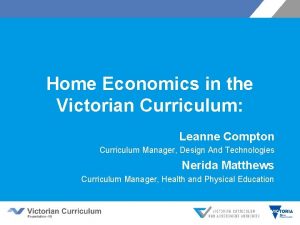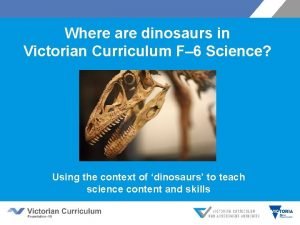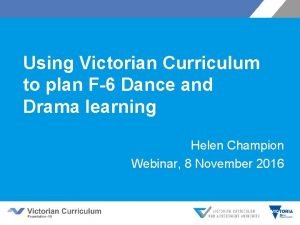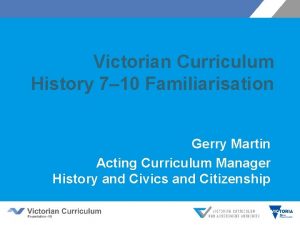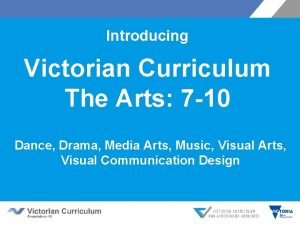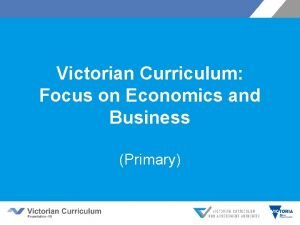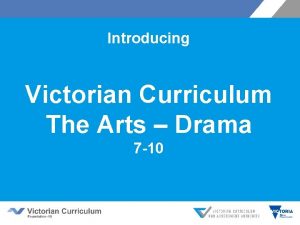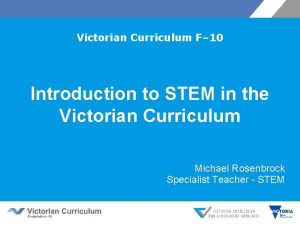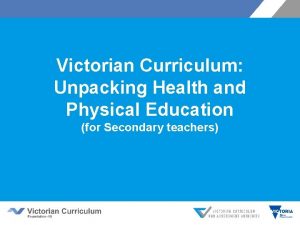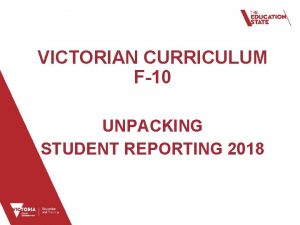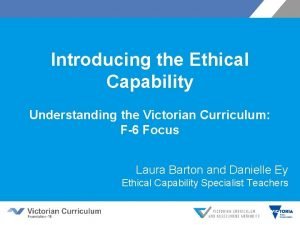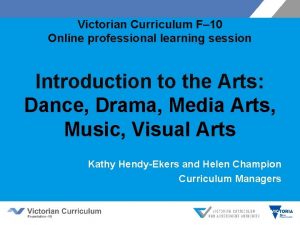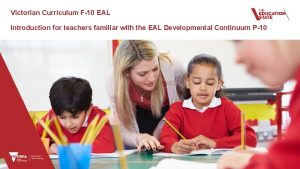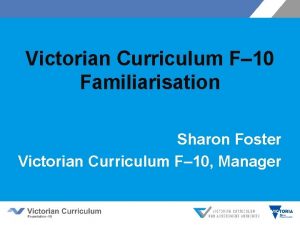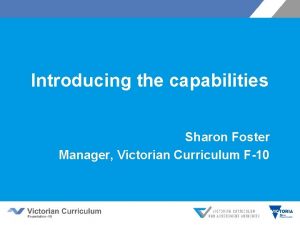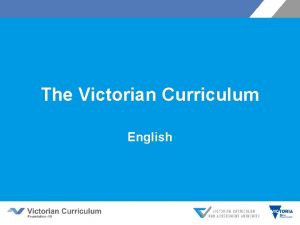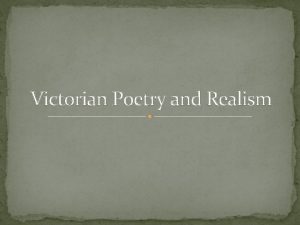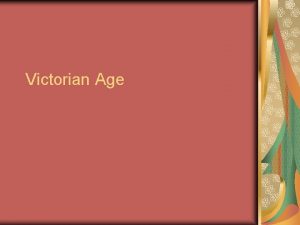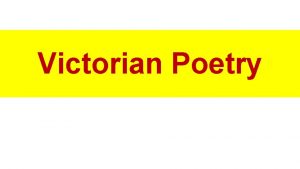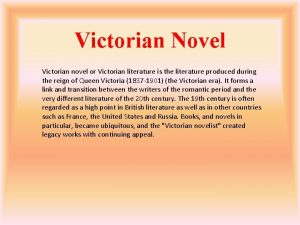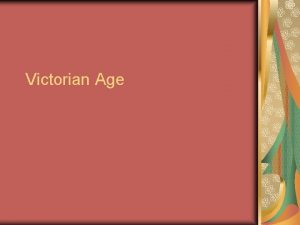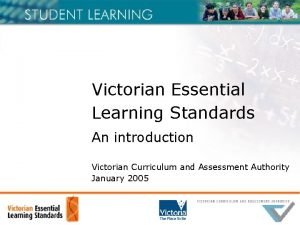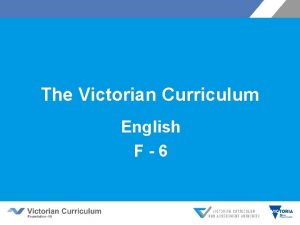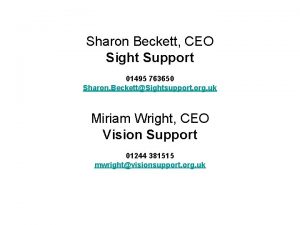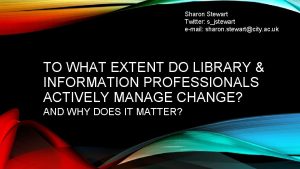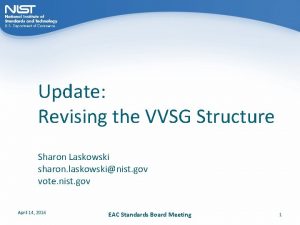Victorian Curriculum F 10 Familiarisation Sharon Foster Victorian



















- Slides: 19

Victorian Curriculum F– 10 Familiarisation Sharon Foster Victorian Curriculum F– 10, Manager

Curriculum • is the statement of the purpose of schooling defines what it is that all students have the opportunity to learn • outlines the public commitment to the learning valued by the community • is represented as a continuum or set of progressions defining increasingly complex knowledge, skills and concepts

Curriculum matters • A guaranteed and viable curriculum is the school level factor that has the most impact on student achievement (Marzano, 2003) • Enabling and monitoring every student’s progress along the continua is the fundamental role of teachers and schools and the purpose and endpoint of all reform efforts

Victorian Curriculum – Design and Structure Design and structure reaffirms: • the importance of discipline-based learning approach, where the disciplines are regarded as both enduring and dynamic • capabilities are a set of discrete knowledge and skills, not a statement of pedagogies and students benefit from explicit instruction • that knowledge and skills are transferrable across the curriculum and therefore are not duplicated. http: //victoriancurriculum. vcaa. vic. edu. au/overview/curriculumdesign/learning-areas-and-capabilities

Victorian Curriculum F– 10 by 2017 Learning Areas Capabilities • • • The Arts o Dance o Drama o Media Arts o Music o Visual Communication Design (7 -10) o Visual Arts English Humanities o Civics and Citizenship o Economics and Business o Geography o History Languages Health and Physical Education Mathematics Science Technologies o Design and Technologies o Digital Technologies Critical and creative thinking Intercultural Ethical Personal and social


Content matters There is important content that every young Victorian should learn: • Australia’s system of government, history and cultures, including Aboriginal and Torres Strait Islander histories and cultures • values of democracy, equity and justice, including reconciliation between Indigenous and non-Indigenous Australians • high levels of enabling skills in English literacy and numeracy • broad knowledge of and appreciation of the importance of the STEM (Science, Technology, Engineering and Mathematics), Humanities and Arts • knowledge and skills necessary for participation in a digital world • how wellbeing and safety can be protected and nurtured • attributes central to participation in the contemporary economy and for civic participation such as creativity and innovation, critical thinking, problem-solving, and learning to learn.

Key features • Structured as a learning continuum that enable teachers to identify the current levels of achievement and then plan for progression • Includes 11 levels for English and Mathematics and bands (5 or 6) for all other Learning Areas and Capabilities • Levels A-D supporting students with disabilities • Cross-curriculum priorities including Aboriginal and Torres Strait Islander histories and culture, Asia and Australia’s engagement with Asia, and Sustainability are embedded in the Learning Areas and Capabilities, not represented as additional or separate curriculum • 4 rather than 7 capabilities included in the curriculum. Additional 3 general capabilities in the Australian Curriculum are Literacy, Numeracy and ICT. Teachers will develop students’ learning of literacy, numeracy and ICT across the curriculum. These capabilities are incorporated in the learning areas and do not require separate treatment.

Strengthened and new content • References to phonics and phonemic awareness strengthened in the English curriculum. • The Digital Technologies F– 10 curriculum includes new learning including computational thinking, developing and evaluating digital solutions and data collection, representation and interpretation. • Learning about coding is included in both the Digital Technologies and Mathematics curriculum. • References to respectful relationships and safety in the home have been strengthened and made more explicit. • For the first time includes Learning about World Views and Religions. Aus. VELS and Australian Curriculum make numerous references to religion (e. g. Australia as a secular and multi-faith society, the role religion played in colonial expansion, the role of religion in global conflicts), but what students should learn about world views and religions has not been specified. Such content has now been developed, in consultation with key religious and secular stakeholders.

Components Introduction Curriculum Rationale and aims Level / band description Structure - strands / sub-strands - placement of standards Learning in. . Content descriptions (+ elaborations – suggestions only) Achievement standards Scope and sequence Glossary

Terminology Aus. VELS - VELS component Victorian Curriculum Domains Curriculum areas Dimensions Strands and sub-strands ------- Content descriptions Learning focus ------- Standards Achievement standards Pathways - Languages only 1: F – 10 2: 7 – 10 Sequence: Languages only 1: F – 10 2: 7 – 10 Pathways: 3 pathways for Chinese language

Placement of standards http: //victoriancurriculum. vcaa. vic. edu. au/overview/curriculum-design/standards-and-levels

A distinction Curriculum is “the what” • described as content descriptions and achievement standards • uncluttered by making clear what is most important for all students to learn • without the “what” students should learn, pedagogy is a process without purpose Teaching and learning program is “the how” • • school based plan for delivering the curriculum reflects local resources, expertise and contexts, and allows for specialisation and innovation The curriculum is not the whole-school teaching and learning program

Locating information Curriculum Resources and Support

Presentation - website Website that provides easy navigation

Presentation A 3 charts

Curriculum planning • Is not the responsibility of the individual teacher – it is a team effort • Recognises that we are educating the whole child across many years of schooling curriculum is designed as a continuum of learning • Without the “what” students should learn, pedagogy is a process without purpose • Deep familiarity with the curriculum is essential http: //curriculumplanning. vcaa. vic. edu. au/home

Curriculum Development • Aus. VELS: the current F– 10 curriculum based on the Australian Curriculum (English, Mathematics, Science, History) and the Victorian Essential Learning Standards (VELS). Released in 2011 for implementation in 2013. This curriculum will be archived in Dec 2016 • Victorian Curriculum F– 10: incorporates the Australian Curriculum and reflects Victorian priorities and standards. The English, Mathematics, Science, and History curriculums from Aus. VELS have been revised. Released in 2015 for implementation by 2017. Can be implemented in 2016 – a school decision.

Contact details VCAA websites Victorian Curriculum http: //victoriancurriculum. vcaa. vic. edu. au/ Aus. VELS Curriculum http: //ausvels. vcaa. vic. edu. au/ Aus. VELS resources and implementation support: http: //www. vcaa. vic. edu. au/Pages/foundation 10/curriculum/index. aspx Curriculum Planning Resources: http: //curriculumplanning. vcaa. vic. edu. au/home Contact details Phone: Sharon Foster (03) 9032 1680 Email: foster. sharon. a@edumail. vic. gov. au
 Roman floral designs
Roman floral designs Renaissance period floral design
Renaissance period floral design Victorian curriculum economics
Victorian curriculum economics Different types of dinosaurs
Different types of dinosaurs Dance curriculum victoria
Dance curriculum victoria Victorian history curriculum
Victorian history curriculum Victorian curriculum arts
Victorian curriculum arts Victorian curriculum economics
Victorian curriculum economics Victorian curriculum drama
Victorian curriculum drama Victorian f-10 curriculum
Victorian f-10 curriculum Victorian curriculum intercultural capability
Victorian curriculum intercultural capability Victorian curriculum physical education
Victorian curriculum physical education Vchpepe
Vchpepe Victorian curriculum visual arts
Victorian curriculum visual arts Critical and creative thinking victorian curriculum
Critical and creative thinking victorian curriculum Victorian curriculum ethical capabilities
Victorian curriculum ethical capabilities Music curriculum victoria
Music curriculum victoria Historical concepts and skills
Historical concepts and skills Victorian curriculum visual arts scope and sequence
Victorian curriculum visual arts scope and sequence Eal curriculum reporting tool
Eal curriculum reporting tool


